Comprehensive Business Environment Analysis of Nestle Corporation
VerifiedAdded on 2020/06/06
|13
|3563
|47
Report
AI Summary
This report provides a comprehensive analysis of Nestle's business environment, encompassing various internal and external factors influencing its operations. It begins with an introduction to the business environment and its significance for strategic decision-making. The report examines the types, purposes, size, scope, and legal structures of different organizations, using Nestle as a case study. It delves into the interrelationship between organizational functions such as human resources, finance, marketing, and production, and their collective role in achieving business objectives. A key aspect of the report is the assessment of the macro environment, including political, economic, social, technological, legal, and environmental factors, and their positive and negative impacts on Nestle's operations. Furthermore, it presents a SWOT analysis to identify Nestle's strengths, weaknesses, opportunities, and threats, and explores the interrelationship of these factors with external macro environmental forces. The report concludes with a summary of key findings and recommendations for Nestle's strategic management.
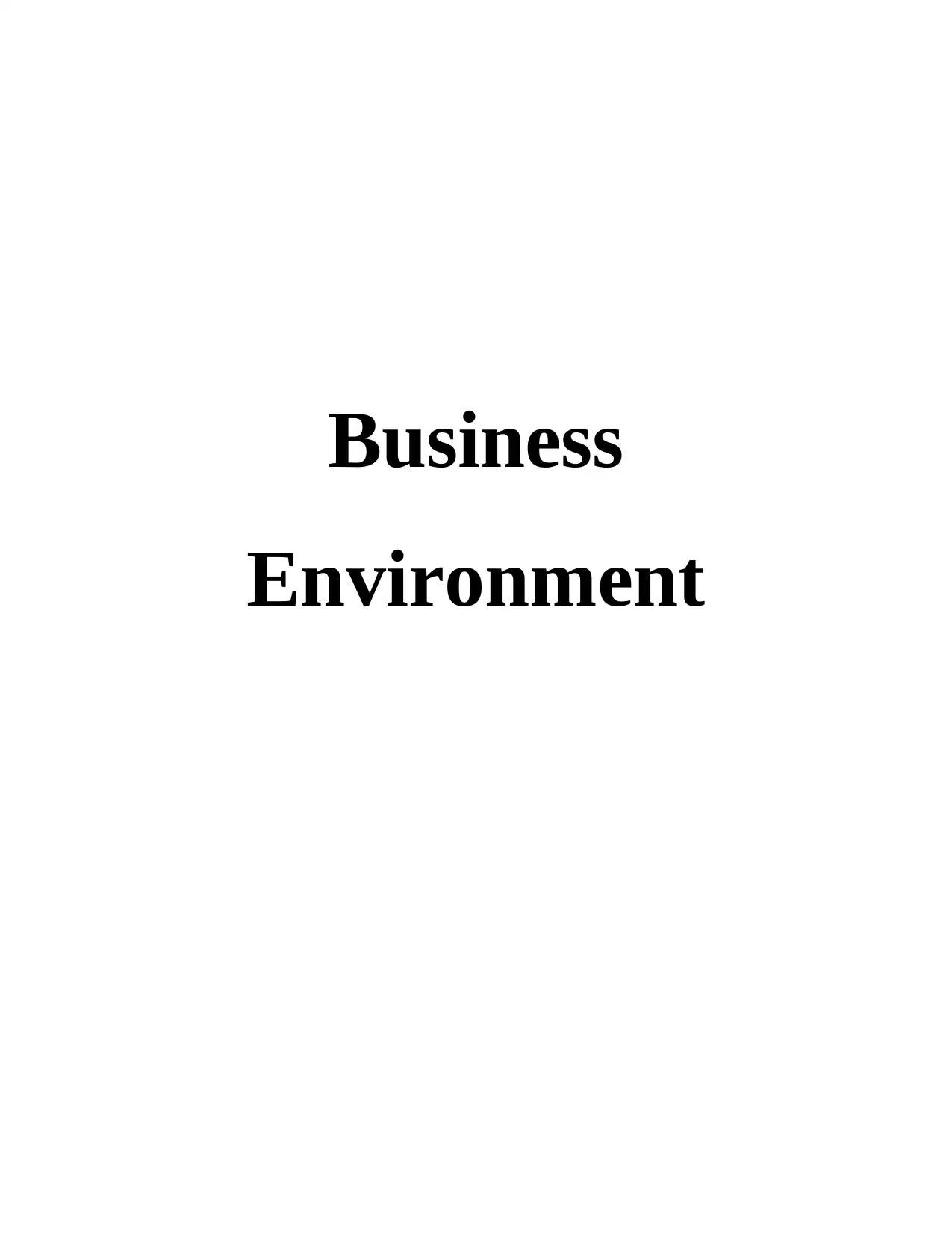
Business
Environment
Environment
Paraphrase This Document
Need a fresh take? Get an instant paraphrase of this document with our AI Paraphraser
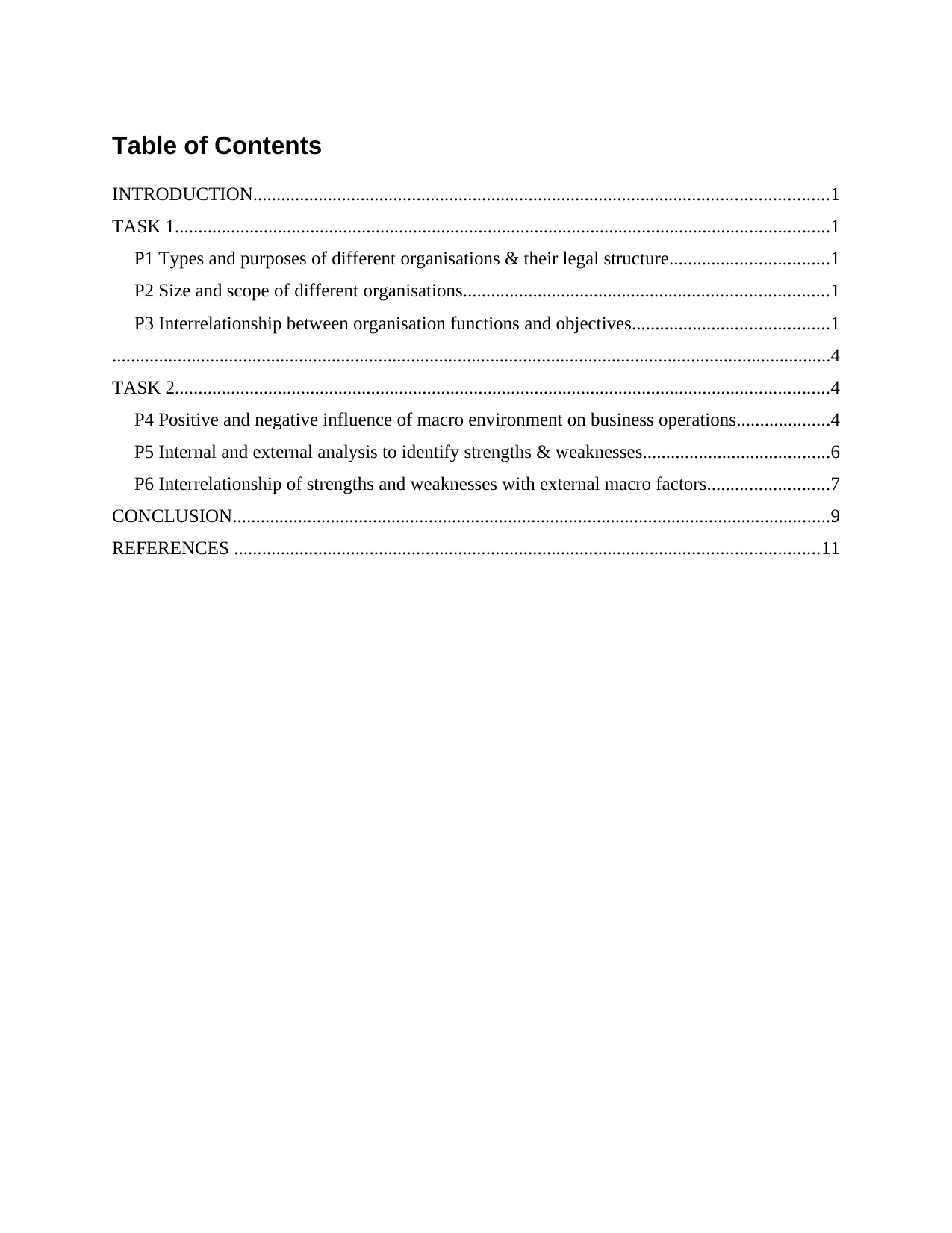
Table of Contents
INTRODUCTION...........................................................................................................................1
TASK 1............................................................................................................................................1
P1 Types and purposes of different organisations & their legal structure..................................1
P2 Size and scope of different organisations..............................................................................1
P3 Interrelationship between organisation functions and objectives..........................................1
..........................................................................................................................................................4
TASK 2............................................................................................................................................4
P4 Positive and negative influence of macro environment on business operations....................4
P5 Internal and external analysis to identify strengths & weaknesses........................................6
P6 Interrelationship of strengths and weaknesses with external macro factors..........................7
CONCLUSION................................................................................................................................9
REFERENCES .............................................................................................................................11
INTRODUCTION...........................................................................................................................1
TASK 1............................................................................................................................................1
P1 Types and purposes of different organisations & their legal structure..................................1
P2 Size and scope of different organisations..............................................................................1
P3 Interrelationship between organisation functions and objectives..........................................1
..........................................................................................................................................................4
TASK 2............................................................................................................................................4
P4 Positive and negative influence of macro environment on business operations....................4
P5 Internal and external analysis to identify strengths & weaknesses........................................6
P6 Interrelationship of strengths and weaknesses with external macro factors..........................7
CONCLUSION................................................................................................................................9
REFERENCES .............................................................................................................................11
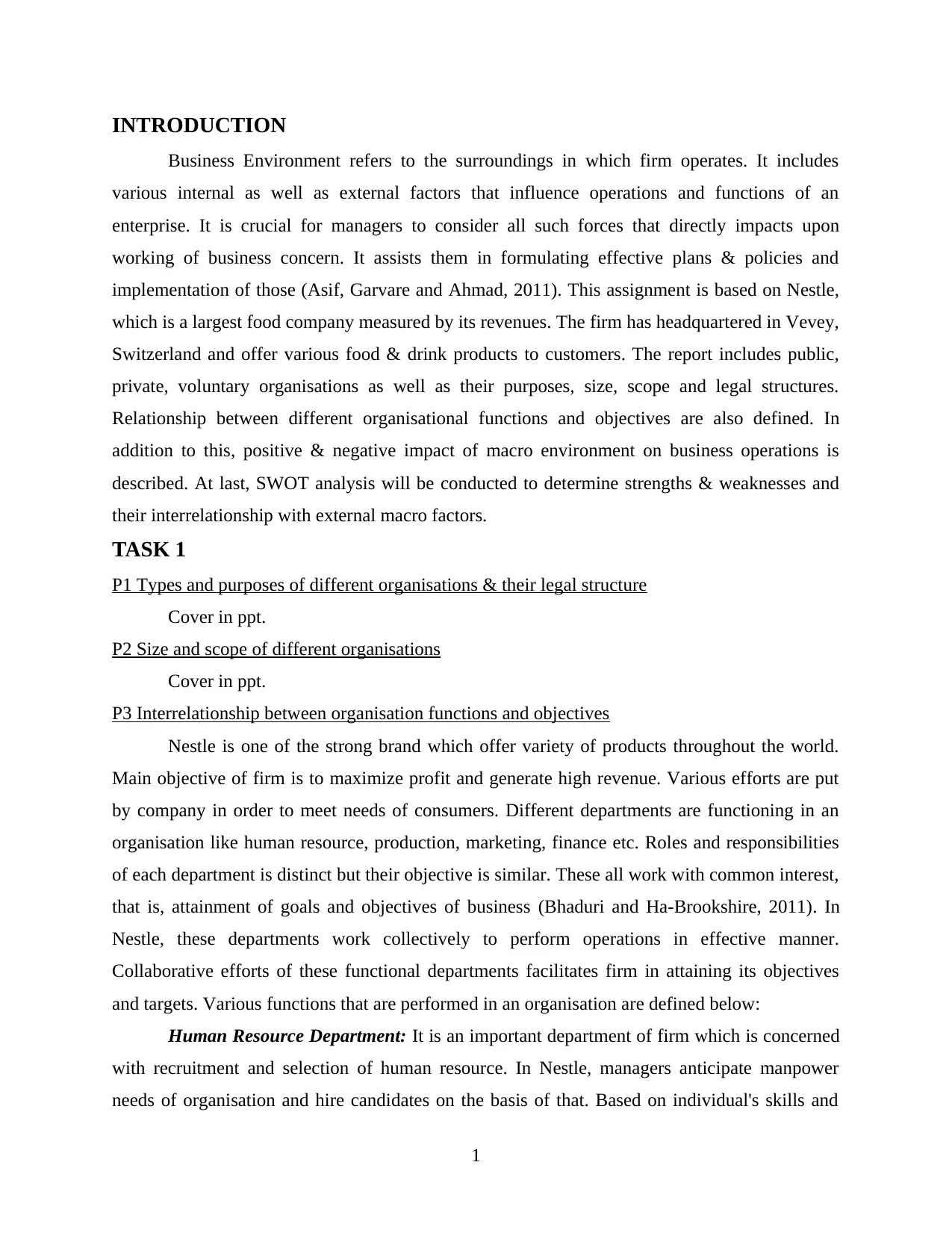
INTRODUCTION
Business Environment refers to the surroundings in which firm operates. It includes
various internal as well as external factors that influence operations and functions of an
enterprise. It is crucial for managers to consider all such forces that directly impacts upon
working of business concern. It assists them in formulating effective plans & policies and
implementation of those (Asif, Garvare and Ahmad, 2011). This assignment is based on Nestle,
which is a largest food company measured by its revenues. The firm has headquartered in Vevey,
Switzerland and offer various food & drink products to customers. The report includes public,
private, voluntary organisations as well as their purposes, size, scope and legal structures.
Relationship between different organisational functions and objectives are also defined. In
addition to this, positive & negative impact of macro environment on business operations is
described. At last, SWOT analysis will be conducted to determine strengths & weaknesses and
their interrelationship with external macro factors.
TASK 1
P1 Types and purposes of different organisations & their legal structure
Cover in ppt.
P2 Size and scope of different organisations
Cover in ppt.
P3 Interrelationship between organisation functions and objectives
Nestle is one of the strong brand which offer variety of products throughout the world.
Main objective of firm is to maximize profit and generate high revenue. Various efforts are put
by company in order to meet needs of consumers. Different departments are functioning in an
organisation like human resource, production, marketing, finance etc. Roles and responsibilities
of each department is distinct but their objective is similar. These all work with common interest,
that is, attainment of goals and objectives of business (Bhaduri and Ha-Brookshire, 2011). In
Nestle, these departments work collectively to perform operations in effective manner.
Collaborative efforts of these functional departments facilitates firm in attaining its objectives
and targets. Various functions that are performed in an organisation are defined below:
Human Resource Department: It is an important department of firm which is concerned
with recruitment and selection of human resource. In Nestle, managers anticipate manpower
needs of organisation and hire candidates on the basis of that. Based on individual's skills and
1
Business Environment refers to the surroundings in which firm operates. It includes
various internal as well as external factors that influence operations and functions of an
enterprise. It is crucial for managers to consider all such forces that directly impacts upon
working of business concern. It assists them in formulating effective plans & policies and
implementation of those (Asif, Garvare and Ahmad, 2011). This assignment is based on Nestle,
which is a largest food company measured by its revenues. The firm has headquartered in Vevey,
Switzerland and offer various food & drink products to customers. The report includes public,
private, voluntary organisations as well as their purposes, size, scope and legal structures.
Relationship between different organisational functions and objectives are also defined. In
addition to this, positive & negative impact of macro environment on business operations is
described. At last, SWOT analysis will be conducted to determine strengths & weaknesses and
their interrelationship with external macro factors.
TASK 1
P1 Types and purposes of different organisations & their legal structure
Cover in ppt.
P2 Size and scope of different organisations
Cover in ppt.
P3 Interrelationship between organisation functions and objectives
Nestle is one of the strong brand which offer variety of products throughout the world.
Main objective of firm is to maximize profit and generate high revenue. Various efforts are put
by company in order to meet needs of consumers. Different departments are functioning in an
organisation like human resource, production, marketing, finance etc. Roles and responsibilities
of each department is distinct but their objective is similar. These all work with common interest,
that is, attainment of goals and objectives of business (Bhaduri and Ha-Brookshire, 2011). In
Nestle, these departments work collectively to perform operations in effective manner.
Collaborative efforts of these functional departments facilitates firm in attaining its objectives
and targets. Various functions that are performed in an organisation are defined below:
Human Resource Department: It is an important department of firm which is concerned
with recruitment and selection of human resource. In Nestle, managers anticipate manpower
needs of organisation and hire candidates on the basis of that. Based on individual's skills and
1
⊘ This is a preview!⊘
Do you want full access?
Subscribe today to unlock all pages.

Trusted by 1+ million students worldwide
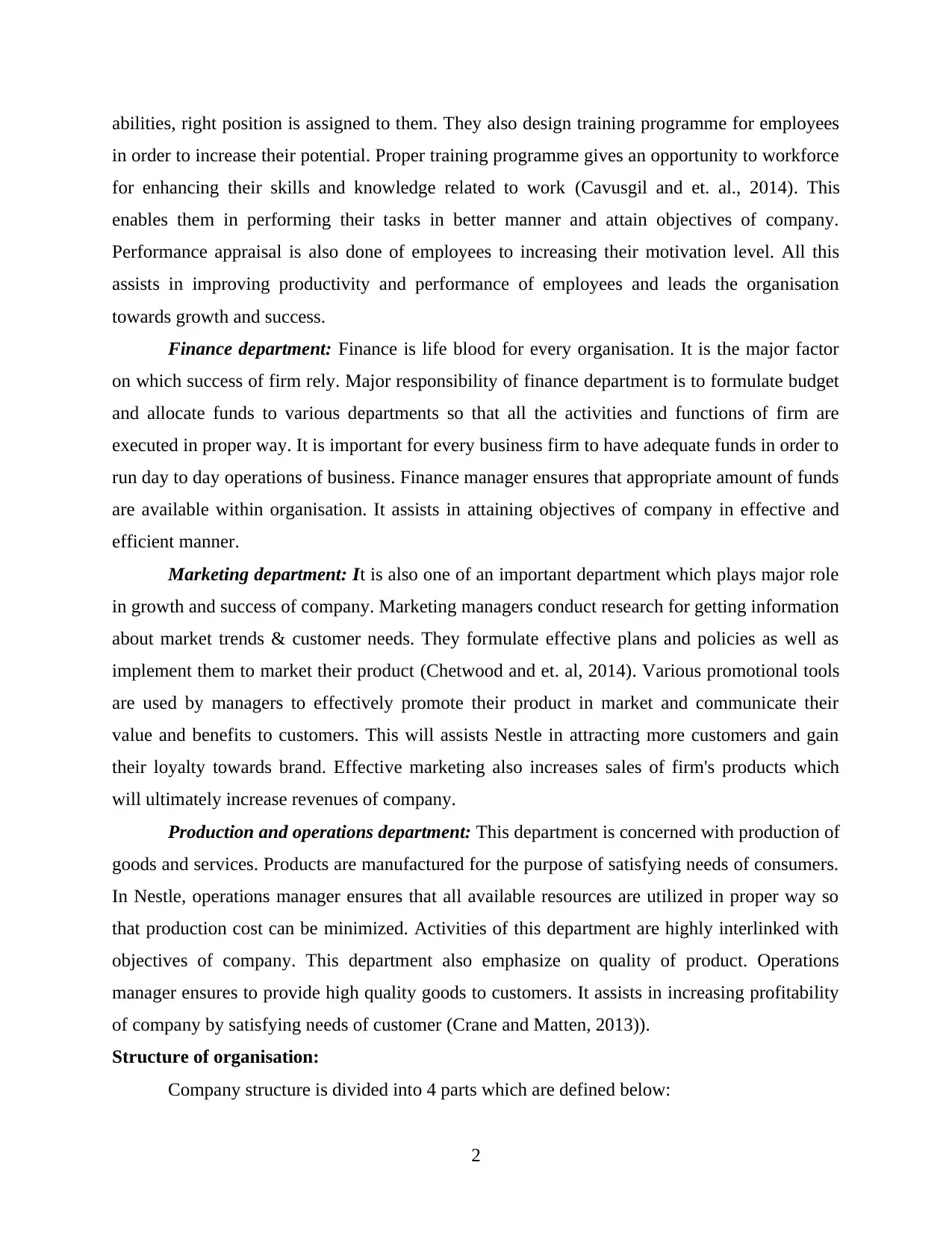
abilities, right position is assigned to them. They also design training programme for employees
in order to increase their potential. Proper training programme gives an opportunity to workforce
for enhancing their skills and knowledge related to work (Cavusgil and et. al., 2014). This
enables them in performing their tasks in better manner and attain objectives of company.
Performance appraisal is also done of employees to increasing their motivation level. All this
assists in improving productivity and performance of employees and leads the organisation
towards growth and success.
Finance department: Finance is life blood for every organisation. It is the major factor
on which success of firm rely. Major responsibility of finance department is to formulate budget
and allocate funds to various departments so that all the activities and functions of firm are
executed in proper way. It is important for every business firm to have adequate funds in order to
run day to day operations of business. Finance manager ensures that appropriate amount of funds
are available within organisation. It assists in attaining objectives of company in effective and
efficient manner.
Marketing department: It is also one of an important department which plays major role
in growth and success of company. Marketing managers conduct research for getting information
about market trends & customer needs. They formulate effective plans and policies as well as
implement them to market their product (Chetwood and et. al, 2014). Various promotional tools
are used by managers to effectively promote their product in market and communicate their
value and benefits to customers. This will assists Nestle in attracting more customers and gain
their loyalty towards brand. Effective marketing also increases sales of firm's products which
will ultimately increase revenues of company.
Production and operations department: This department is concerned with production of
goods and services. Products are manufactured for the purpose of satisfying needs of consumers.
In Nestle, operations manager ensures that all available resources are utilized in proper way so
that production cost can be minimized. Activities of this department are highly interlinked with
objectives of company. This department also emphasize on quality of product. Operations
manager ensures to provide high quality goods to customers. It assists in increasing profitability
of company by satisfying needs of customer (Crane and Matten, 2013)).
Structure of organisation:
Company structure is divided into 4 parts which are defined below:
2
in order to increase their potential. Proper training programme gives an opportunity to workforce
for enhancing their skills and knowledge related to work (Cavusgil and et. al., 2014). This
enables them in performing their tasks in better manner and attain objectives of company.
Performance appraisal is also done of employees to increasing their motivation level. All this
assists in improving productivity and performance of employees and leads the organisation
towards growth and success.
Finance department: Finance is life blood for every organisation. It is the major factor
on which success of firm rely. Major responsibility of finance department is to formulate budget
and allocate funds to various departments so that all the activities and functions of firm are
executed in proper way. It is important for every business firm to have adequate funds in order to
run day to day operations of business. Finance manager ensures that appropriate amount of funds
are available within organisation. It assists in attaining objectives of company in effective and
efficient manner.
Marketing department: It is also one of an important department which plays major role
in growth and success of company. Marketing managers conduct research for getting information
about market trends & customer needs. They formulate effective plans and policies as well as
implement them to market their product (Chetwood and et. al, 2014). Various promotional tools
are used by managers to effectively promote their product in market and communicate their
value and benefits to customers. This will assists Nestle in attracting more customers and gain
their loyalty towards brand. Effective marketing also increases sales of firm's products which
will ultimately increase revenues of company.
Production and operations department: This department is concerned with production of
goods and services. Products are manufactured for the purpose of satisfying needs of consumers.
In Nestle, operations manager ensures that all available resources are utilized in proper way so
that production cost can be minimized. Activities of this department are highly interlinked with
objectives of company. This department also emphasize on quality of product. Operations
manager ensures to provide high quality goods to customers. It assists in increasing profitability
of company by satisfying needs of customer (Crane and Matten, 2013)).
Structure of organisation:
Company structure is divided into 4 parts which are defined below:
2
Paraphrase This Document
Need a fresh take? Get an instant paraphrase of this document with our AI Paraphraser
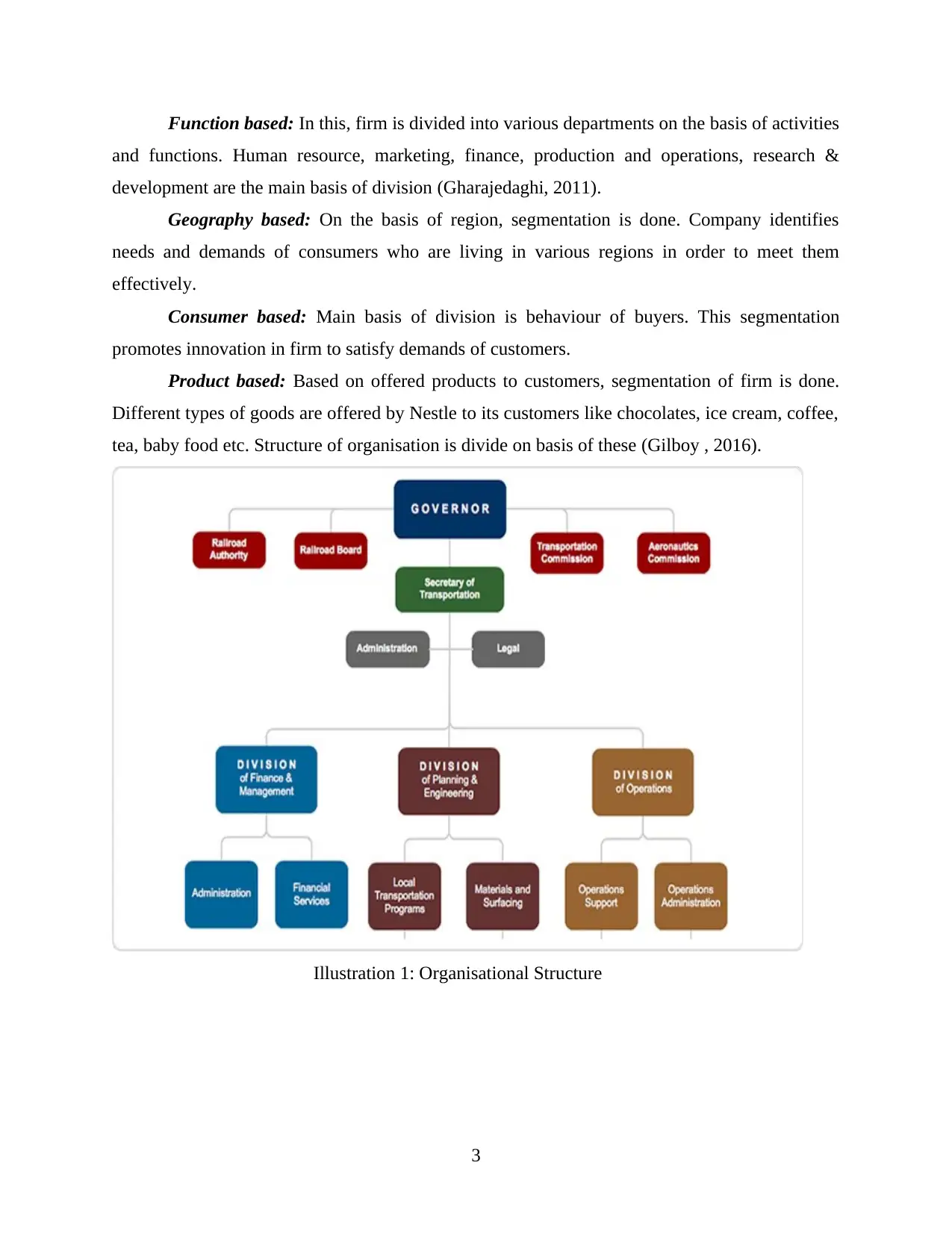
Function based: In this, firm is divided into various departments on the basis of activities
and functions. Human resource, marketing, finance, production and operations, research &
development are the main basis of division (Gharajedaghi, 2011).
Geography based: On the basis of region, segmentation is done. Company identifies
needs and demands of consumers who are living in various regions in order to meet them
effectively.
Consumer based: Main basis of division is behaviour of buyers. This segmentation
promotes innovation in firm to satisfy demands of customers.
Product based: Based on offered products to customers, segmentation of firm is done.
Different types of goods are offered by Nestle to its customers like chocolates, ice cream, coffee,
tea, baby food etc. Structure of organisation is divide on basis of these (Gilboy , 2016).
Illustration 1: Organisational Structure
3
and functions. Human resource, marketing, finance, production and operations, research &
development are the main basis of division (Gharajedaghi, 2011).
Geography based: On the basis of region, segmentation is done. Company identifies
needs and demands of consumers who are living in various regions in order to meet them
effectively.
Consumer based: Main basis of division is behaviour of buyers. This segmentation
promotes innovation in firm to satisfy demands of customers.
Product based: Based on offered products to customers, segmentation of firm is done.
Different types of goods are offered by Nestle to its customers like chocolates, ice cream, coffee,
tea, baby food etc. Structure of organisation is divide on basis of these (Gilboy , 2016).
Illustration 1: Organisational Structure
3
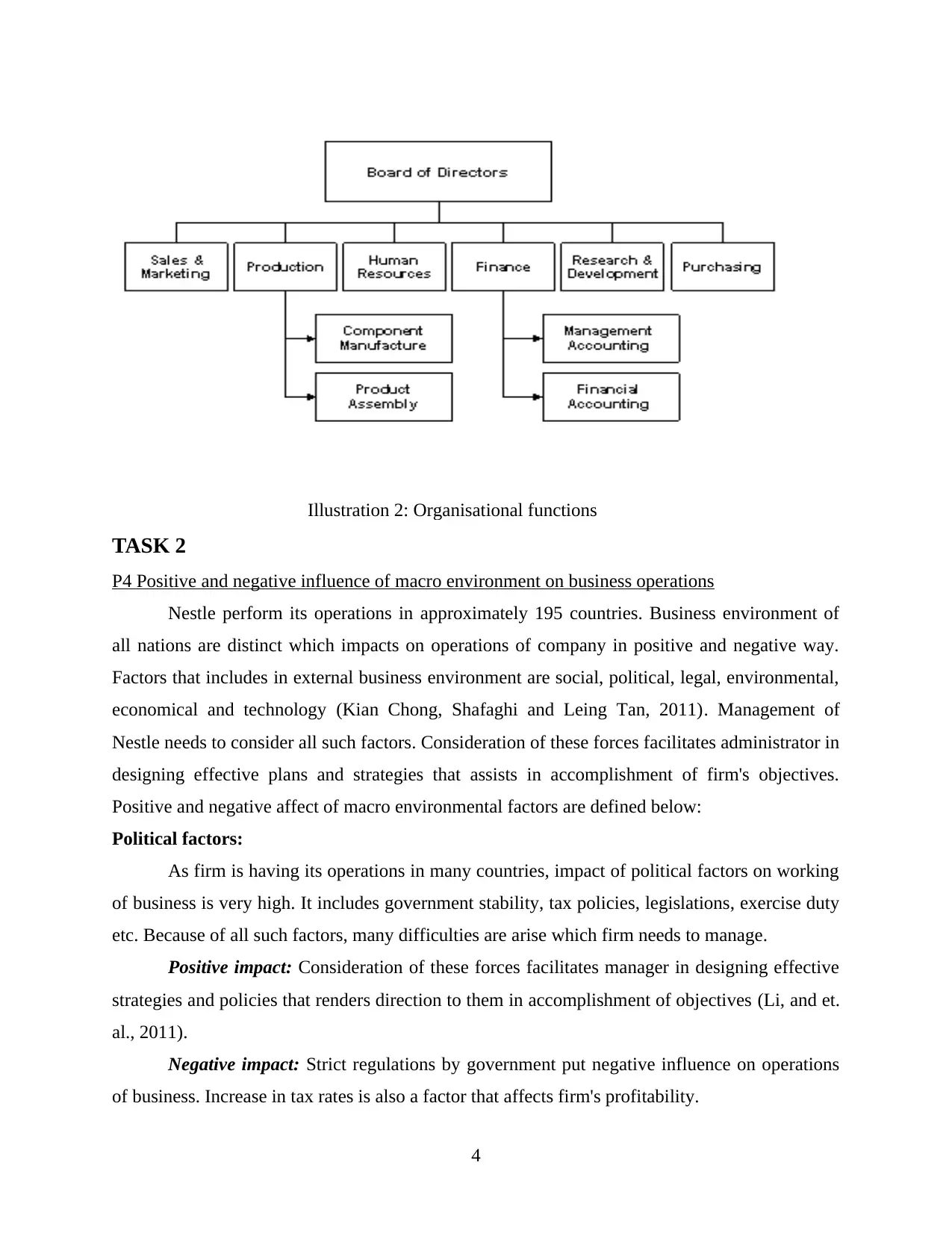
Illustration 2: Organisational functions
TASK 2
P4 Positive and negative influence of macro environment on business operations
Nestle perform its operations in approximately 195 countries. Business environment of
all nations are distinct which impacts on operations of company in positive and negative way.
Factors that includes in external business environment are social, political, legal, environmental,
economical and technology (Kian Chong, Shafaghi and Leing Tan, 2011). Management of
Nestle needs to consider all such factors. Consideration of these forces facilitates administrator in
designing effective plans and strategies that assists in accomplishment of firm's objectives.
Positive and negative affect of macro environmental factors are defined below:
Political factors:
As firm is having its operations in many countries, impact of political factors on working
of business is very high. It includes government stability, tax policies, legislations, exercise duty
etc. Because of all such factors, many difficulties are arise which firm needs to manage.
Positive impact: Consideration of these forces facilitates manager in designing effective
strategies and policies that renders direction to them in accomplishment of objectives (Li, and et.
al., 2011).
Negative impact: Strict regulations by government put negative influence on operations
of business. Increase in tax rates is also a factor that affects firm's profitability.
4
TASK 2
P4 Positive and negative influence of macro environment on business operations
Nestle perform its operations in approximately 195 countries. Business environment of
all nations are distinct which impacts on operations of company in positive and negative way.
Factors that includes in external business environment are social, political, legal, environmental,
economical and technology (Kian Chong, Shafaghi and Leing Tan, 2011). Management of
Nestle needs to consider all such factors. Consideration of these forces facilitates administrator in
designing effective plans and strategies that assists in accomplishment of firm's objectives.
Positive and negative affect of macro environmental factors are defined below:
Political factors:
As firm is having its operations in many countries, impact of political factors on working
of business is very high. It includes government stability, tax policies, legislations, exercise duty
etc. Because of all such factors, many difficulties are arise which firm needs to manage.
Positive impact: Consideration of these forces facilitates manager in designing effective
strategies and policies that renders direction to them in accomplishment of objectives (Li, and et.
al., 2011).
Negative impact: Strict regulations by government put negative influence on operations
of business. Increase in tax rates is also a factor that affects firm's profitability.
4
⊘ This is a preview!⊘
Do you want full access?
Subscribe today to unlock all pages.

Trusted by 1+ million students worldwide
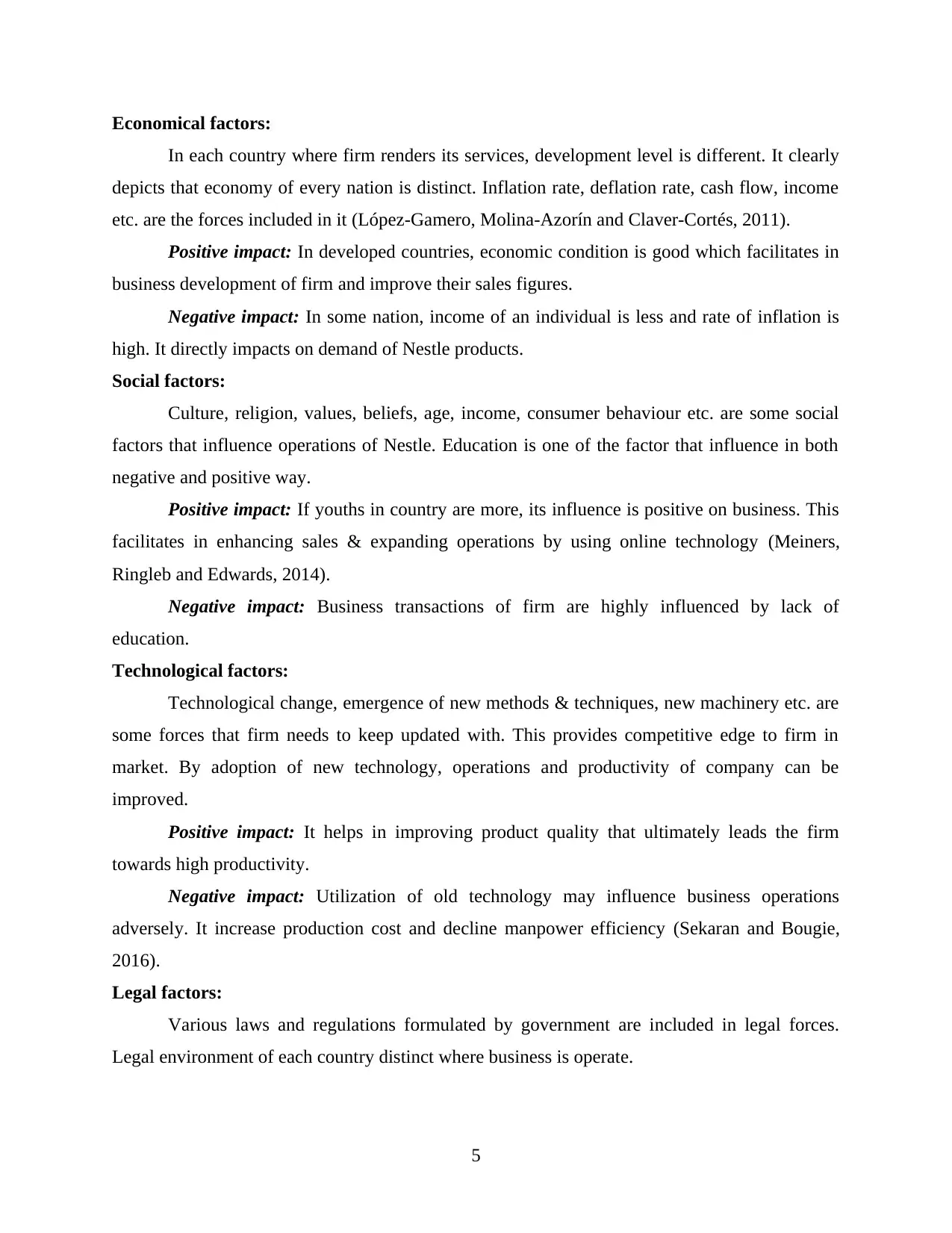
Economical factors:
In each country where firm renders its services, development level is different. It clearly
depicts that economy of every nation is distinct. Inflation rate, deflation rate, cash flow, income
etc. are the forces included in it (López-Gamero, Molina-Azorín and Claver-Cortés, 2011).
Positive impact: In developed countries, economic condition is good which facilitates in
business development of firm and improve their sales figures.
Negative impact: In some nation, income of an individual is less and rate of inflation is
high. It directly impacts on demand of Nestle products.
Social factors:
Culture, religion, values, beliefs, age, income, consumer behaviour etc. are some social
factors that influence operations of Nestle. Education is one of the factor that influence in both
negative and positive way.
Positive impact: If youths in country are more, its influence is positive on business. This
facilitates in enhancing sales & expanding operations by using online technology (Meiners,
Ringleb and Edwards, 2014).
Negative impact: Business transactions of firm are highly influenced by lack of
education.
Technological factors:
Technological change, emergence of new methods & techniques, new machinery etc. are
some forces that firm needs to keep updated with. This provides competitive edge to firm in
market. By adoption of new technology, operations and productivity of company can be
improved.
Positive impact: It helps in improving product quality that ultimately leads the firm
towards high productivity.
Negative impact: Utilization of old technology may influence business operations
adversely. It increase production cost and decline manpower efficiency (Sekaran and Bougie,
2016).
Legal factors:
Various laws and regulations formulated by government are included in legal forces.
Legal environment of each country distinct where business is operate.
5
In each country where firm renders its services, development level is different. It clearly
depicts that economy of every nation is distinct. Inflation rate, deflation rate, cash flow, income
etc. are the forces included in it (López-Gamero, Molina-Azorín and Claver-Cortés, 2011).
Positive impact: In developed countries, economic condition is good which facilitates in
business development of firm and improve their sales figures.
Negative impact: In some nation, income of an individual is less and rate of inflation is
high. It directly impacts on demand of Nestle products.
Social factors:
Culture, religion, values, beliefs, age, income, consumer behaviour etc. are some social
factors that influence operations of Nestle. Education is one of the factor that influence in both
negative and positive way.
Positive impact: If youths in country are more, its influence is positive on business. This
facilitates in enhancing sales & expanding operations by using online technology (Meiners,
Ringleb and Edwards, 2014).
Negative impact: Business transactions of firm are highly influenced by lack of
education.
Technological factors:
Technological change, emergence of new methods & techniques, new machinery etc. are
some forces that firm needs to keep updated with. This provides competitive edge to firm in
market. By adoption of new technology, operations and productivity of company can be
improved.
Positive impact: It helps in improving product quality that ultimately leads the firm
towards high productivity.
Negative impact: Utilization of old technology may influence business operations
adversely. It increase production cost and decline manpower efficiency (Sekaran and Bougie,
2016).
Legal factors:
Various laws and regulations formulated by government are included in legal forces.
Legal environment of each country distinct where business is operate.
5
Paraphrase This Document
Need a fresh take? Get an instant paraphrase of this document with our AI Paraphraser
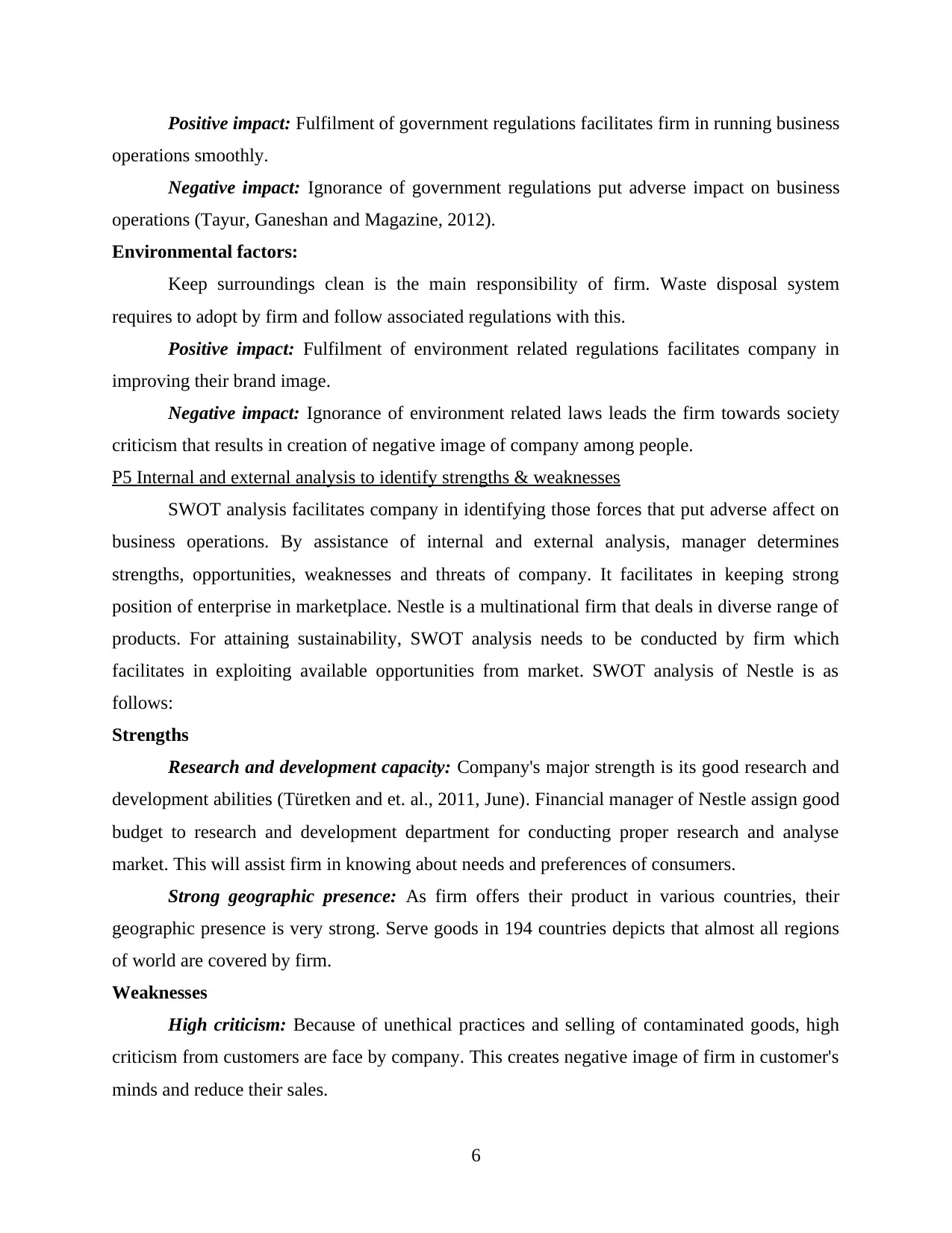
Positive impact: Fulfilment of government regulations facilitates firm in running business
operations smoothly.
Negative impact: Ignorance of government regulations put adverse impact on business
operations (Tayur, Ganeshan and Magazine, 2012).
Environmental factors:
Keep surroundings clean is the main responsibility of firm. Waste disposal system
requires to adopt by firm and follow associated regulations with this.
Positive impact: Fulfilment of environment related regulations facilitates company in
improving their brand image.
Negative impact: Ignorance of environment related laws leads the firm towards society
criticism that results in creation of negative image of company among people.
P5 Internal and external analysis to identify strengths & weaknesses
SWOT analysis facilitates company in identifying those forces that put adverse affect on
business operations. By assistance of internal and external analysis, manager determines
strengths, opportunities, weaknesses and threats of company. It facilitates in keeping strong
position of enterprise in marketplace. Nestle is a multinational firm that deals in diverse range of
products. For attaining sustainability, SWOT analysis needs to be conducted by firm which
facilitates in exploiting available opportunities from market. SWOT analysis of Nestle is as
follows:
Strengths
Research and development capacity: Company's major strength is its good research and
development abilities (Türetken and et. al., 2011, June). Financial manager of Nestle assign good
budget to research and development department for conducting proper research and analyse
market. This will assist firm in knowing about needs and preferences of consumers.
Strong geographic presence: As firm offers their product in various countries, their
geographic presence is very strong. Serve goods in 194 countries depicts that almost all regions
of world are covered by firm.
Weaknesses
High criticism: Because of unethical practices and selling of contaminated goods, high
criticism from customers are face by company. This creates negative image of firm in customer's
minds and reduce their sales.
6
operations smoothly.
Negative impact: Ignorance of government regulations put adverse impact on business
operations (Tayur, Ganeshan and Magazine, 2012).
Environmental factors:
Keep surroundings clean is the main responsibility of firm. Waste disposal system
requires to adopt by firm and follow associated regulations with this.
Positive impact: Fulfilment of environment related regulations facilitates company in
improving their brand image.
Negative impact: Ignorance of environment related laws leads the firm towards society
criticism that results in creation of negative image of company among people.
P5 Internal and external analysis to identify strengths & weaknesses
SWOT analysis facilitates company in identifying those forces that put adverse affect on
business operations. By assistance of internal and external analysis, manager determines
strengths, opportunities, weaknesses and threats of company. It facilitates in keeping strong
position of enterprise in marketplace. Nestle is a multinational firm that deals in diverse range of
products. For attaining sustainability, SWOT analysis needs to be conducted by firm which
facilitates in exploiting available opportunities from market. SWOT analysis of Nestle is as
follows:
Strengths
Research and development capacity: Company's major strength is its good research and
development abilities (Türetken and et. al., 2011, June). Financial manager of Nestle assign good
budget to research and development department for conducting proper research and analyse
market. This will assist firm in knowing about needs and preferences of consumers.
Strong geographic presence: As firm offers their product in various countries, their
geographic presence is very strong. Serve goods in 194 countries depicts that almost all regions
of world are covered by firm.
Weaknesses
High criticism: Because of unethical practices and selling of contaminated goods, high
criticism from customers are face by company. This creates negative image of firm in customer's
minds and reduce their sales.
6
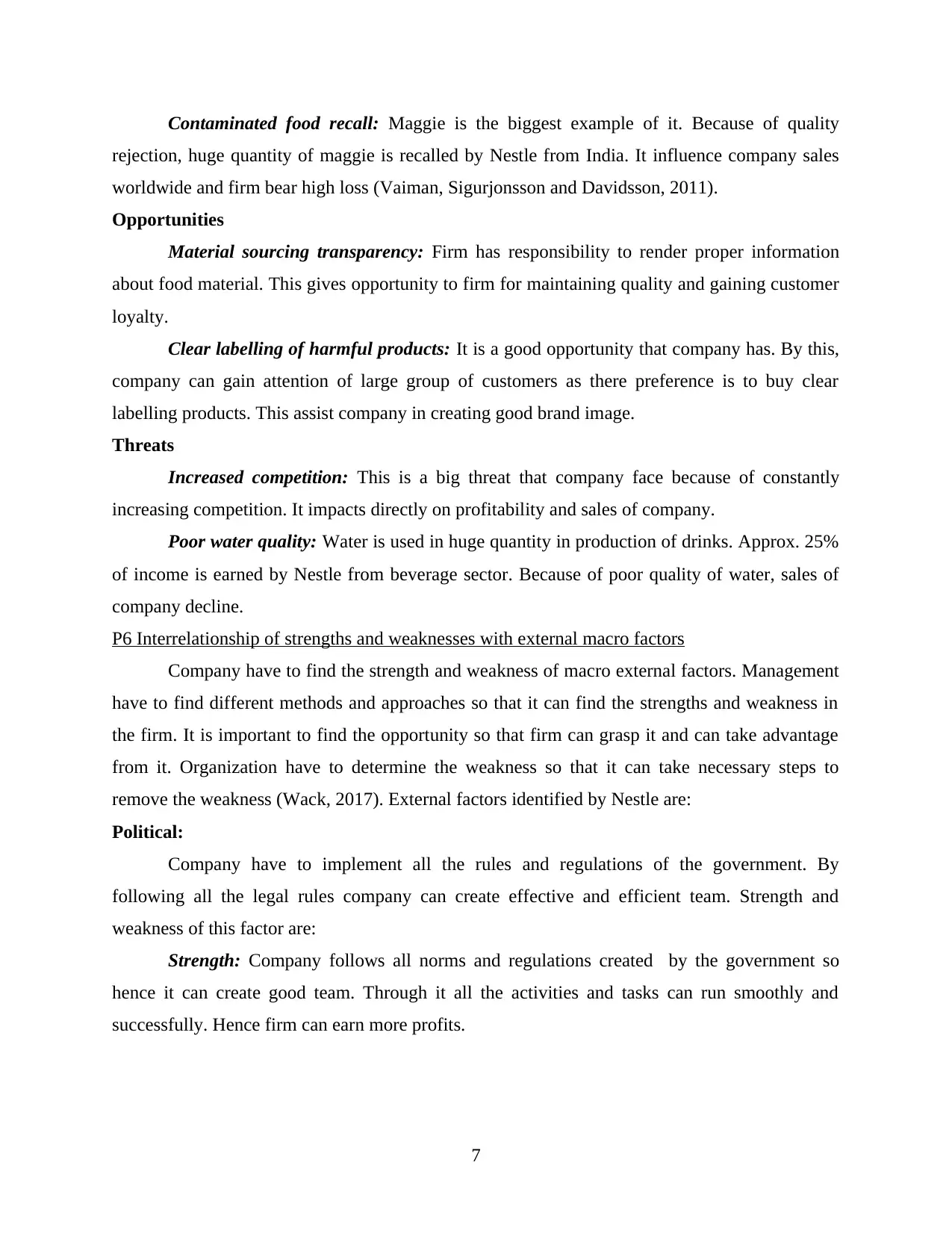
Contaminated food recall: Maggie is the biggest example of it. Because of quality
rejection, huge quantity of maggie is recalled by Nestle from India. It influence company sales
worldwide and firm bear high loss (Vaiman, Sigurjonsson and Davidsson, 2011).
Opportunities
Material sourcing transparency: Firm has responsibility to render proper information
about food material. This gives opportunity to firm for maintaining quality and gaining customer
loyalty.
Clear labelling of harmful products: It is a good opportunity that company has. By this,
company can gain attention of large group of customers as there preference is to buy clear
labelling products. This assist company in creating good brand image.
Threats
Increased competition: This is a big threat that company face because of constantly
increasing competition. It impacts directly on profitability and sales of company.
Poor water quality: Water is used in huge quantity in production of drinks. Approx. 25%
of income is earned by Nestle from beverage sector. Because of poor quality of water, sales of
company decline.
P6 Interrelationship of strengths and weaknesses with external macro factors
Company have to find the strength and weakness of macro external factors. Management
have to find different methods and approaches so that it can find the strengths and weakness in
the firm. It is important to find the opportunity so that firm can grasp it and can take advantage
from it. Organization have to determine the weakness so that it can take necessary steps to
remove the weakness (Wack, 2017). External factors identified by Nestle are:
Political:
Company have to implement all the rules and regulations of the government. By
following all the legal rules company can create effective and efficient team. Strength and
weakness of this factor are:
Strength: Company follows all norms and regulations created by the government so
hence it can create good team. Through it all the activities and tasks can run smoothly and
successfully. Hence firm can earn more profits.
7
rejection, huge quantity of maggie is recalled by Nestle from India. It influence company sales
worldwide and firm bear high loss (Vaiman, Sigurjonsson and Davidsson, 2011).
Opportunities
Material sourcing transparency: Firm has responsibility to render proper information
about food material. This gives opportunity to firm for maintaining quality and gaining customer
loyalty.
Clear labelling of harmful products: It is a good opportunity that company has. By this,
company can gain attention of large group of customers as there preference is to buy clear
labelling products. This assist company in creating good brand image.
Threats
Increased competition: This is a big threat that company face because of constantly
increasing competition. It impacts directly on profitability and sales of company.
Poor water quality: Water is used in huge quantity in production of drinks. Approx. 25%
of income is earned by Nestle from beverage sector. Because of poor quality of water, sales of
company decline.
P6 Interrelationship of strengths and weaknesses with external macro factors
Company have to find the strength and weakness of macro external factors. Management
have to find different methods and approaches so that it can find the strengths and weakness in
the firm. It is important to find the opportunity so that firm can grasp it and can take advantage
from it. Organization have to determine the weakness so that it can take necessary steps to
remove the weakness (Wack, 2017). External factors identified by Nestle are:
Political:
Company have to implement all the rules and regulations of the government. By
following all the legal rules company can create effective and efficient team. Strength and
weakness of this factor are:
Strength: Company follows all norms and regulations created by the government so
hence it can create good team. Through it all the activities and tasks can run smoothly and
successfully. Hence firm can earn more profits.
7
⊘ This is a preview!⊘
Do you want full access?
Subscribe today to unlock all pages.

Trusted by 1+ million students worldwide
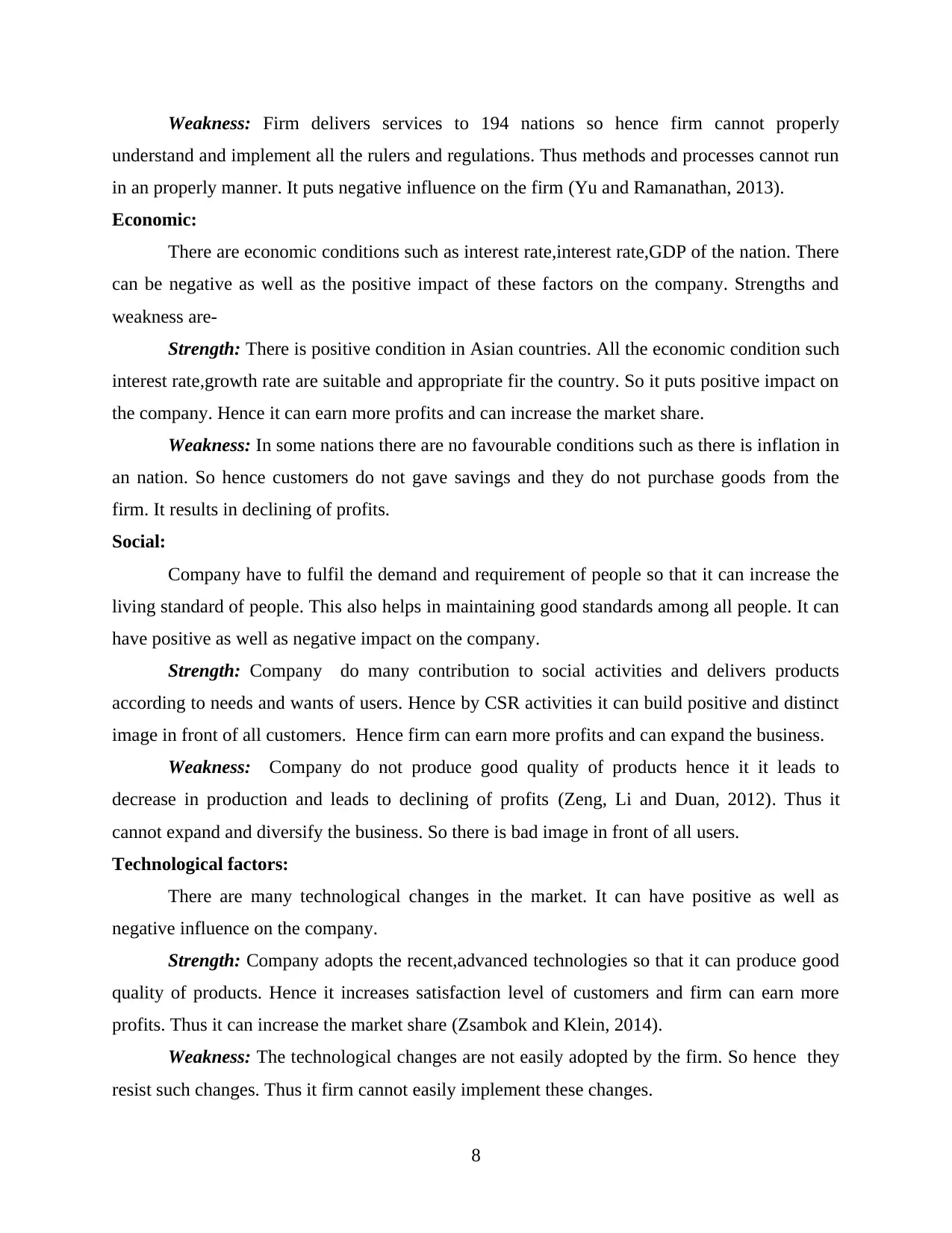
Weakness: Firm delivers services to 194 nations so hence firm cannot properly
understand and implement all the rulers and regulations. Thus methods and processes cannot run
in an properly manner. It puts negative influence on the firm (Yu and Ramanathan, 2013).
Economic:
There are economic conditions such as interest rate,interest rate,GDP of the nation. There
can be negative as well as the positive impact of these factors on the company. Strengths and
weakness are-
Strength: There is positive condition in Asian countries. All the economic condition such
interest rate,growth rate are suitable and appropriate fir the country. So it puts positive impact on
the company. Hence it can earn more profits and can increase the market share.
Weakness: In some nations there are no favourable conditions such as there is inflation in
an nation. So hence customers do not gave savings and they do not purchase goods from the
firm. It results in declining of profits.
Social:
Company have to fulfil the demand and requirement of people so that it can increase the
living standard of people. This also helps in maintaining good standards among all people. It can
have positive as well as negative impact on the company.
Strength: Company do many contribution to social activities and delivers products
according to needs and wants of users. Hence by CSR activities it can build positive and distinct
image in front of all customers. Hence firm can earn more profits and can expand the business.
Weakness: Company do not produce good quality of products hence it it leads to
decrease in production and leads to declining of profits (Zeng, Li and Duan, 2012). Thus it
cannot expand and diversify the business. So there is bad image in front of all users.
Technological factors:
There are many technological changes in the market. It can have positive as well as
negative influence on the company.
Strength: Company adopts the recent,advanced technologies so that it can produce good
quality of products. Hence it increases satisfaction level of customers and firm can earn more
profits. Thus it can increase the market share (Zsambok and Klein, 2014).
Weakness: The technological changes are not easily adopted by the firm. So hence they
resist such changes. Thus it firm cannot easily implement these changes.
8
understand and implement all the rulers and regulations. Thus methods and processes cannot run
in an properly manner. It puts negative influence on the firm (Yu and Ramanathan, 2013).
Economic:
There are economic conditions such as interest rate,interest rate,GDP of the nation. There
can be negative as well as the positive impact of these factors on the company. Strengths and
weakness are-
Strength: There is positive condition in Asian countries. All the economic condition such
interest rate,growth rate are suitable and appropriate fir the country. So it puts positive impact on
the company. Hence it can earn more profits and can increase the market share.
Weakness: In some nations there are no favourable conditions such as there is inflation in
an nation. So hence customers do not gave savings and they do not purchase goods from the
firm. It results in declining of profits.
Social:
Company have to fulfil the demand and requirement of people so that it can increase the
living standard of people. This also helps in maintaining good standards among all people. It can
have positive as well as negative impact on the company.
Strength: Company do many contribution to social activities and delivers products
according to needs and wants of users. Hence by CSR activities it can build positive and distinct
image in front of all customers. Hence firm can earn more profits and can expand the business.
Weakness: Company do not produce good quality of products hence it it leads to
decrease in production and leads to declining of profits (Zeng, Li and Duan, 2012). Thus it
cannot expand and diversify the business. So there is bad image in front of all users.
Technological factors:
There are many technological changes in the market. It can have positive as well as
negative influence on the company.
Strength: Company adopts the recent,advanced technologies so that it can produce good
quality of products. Hence it increases satisfaction level of customers and firm can earn more
profits. Thus it can increase the market share (Zsambok and Klein, 2014).
Weakness: The technological changes are not easily adopted by the firm. So hence they
resist such changes. Thus it firm cannot easily implement these changes.
8
Paraphrase This Document
Need a fresh take? Get an instant paraphrase of this document with our AI Paraphraser
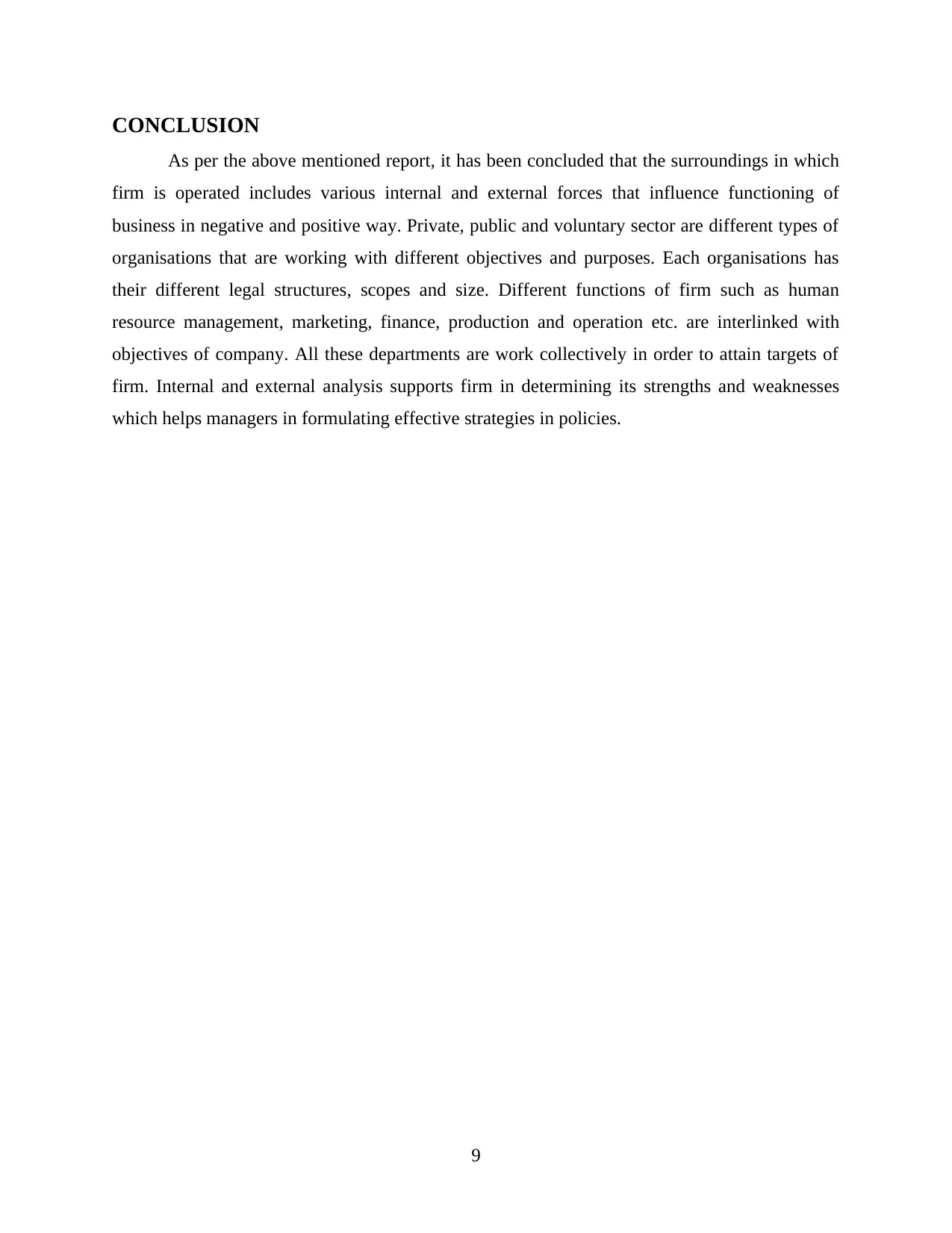
CONCLUSION
As per the above mentioned report, it has been concluded that the surroundings in which
firm is operated includes various internal and external forces that influence functioning of
business in negative and positive way. Private, public and voluntary sector are different types of
organisations that are working with different objectives and purposes. Each organisations has
their different legal structures, scopes and size. Different functions of firm such as human
resource management, marketing, finance, production and operation etc. are interlinked with
objectives of company. All these departments are work collectively in order to attain targets of
firm. Internal and external analysis supports firm in determining its strengths and weaknesses
which helps managers in formulating effective strategies in policies.
9
As per the above mentioned report, it has been concluded that the surroundings in which
firm is operated includes various internal and external forces that influence functioning of
business in negative and positive way. Private, public and voluntary sector are different types of
organisations that are working with different objectives and purposes. Each organisations has
their different legal structures, scopes and size. Different functions of firm such as human
resource management, marketing, finance, production and operation etc. are interlinked with
objectives of company. All these departments are work collectively in order to attain targets of
firm. Internal and external analysis supports firm in determining its strengths and weaknesses
which helps managers in formulating effective strategies in policies.
9
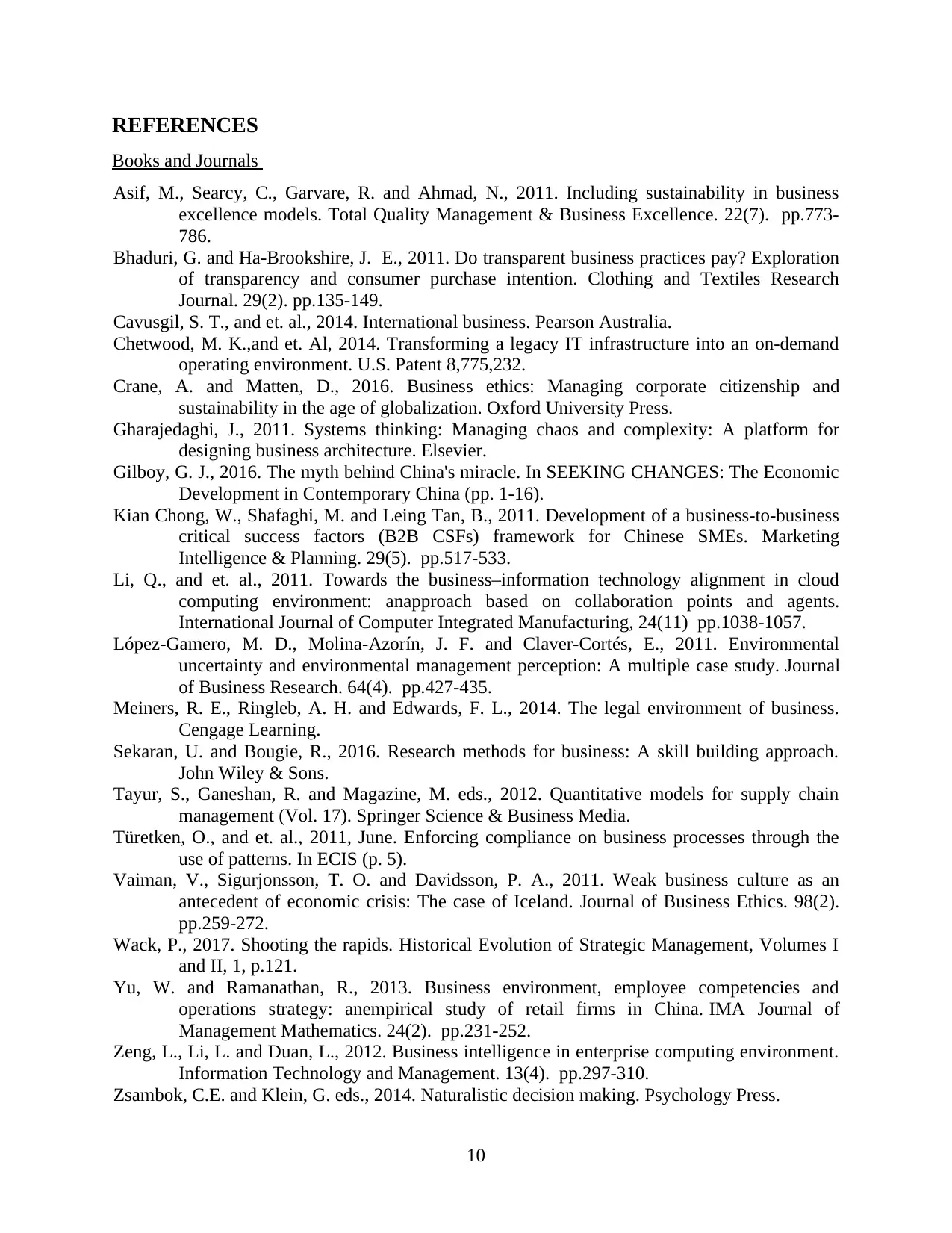
REFERENCES
Books and Journals
Asif, M., Searcy, C., Garvare, R. and Ahmad, N., 2011. Including sustainability in business
excellence models. Total Quality Management & Business Excellence. 22(7). pp.773-
786.
Bhaduri, G. and Ha-Brookshire, J. E., 2011. Do transparent business practices pay? Exploration
of transparency and consumer purchase intention. Clothing and Textiles Research
Journal. 29(2). pp.135-149.
Cavusgil, S. T., and et. al., 2014. International business. Pearson Australia.
Chetwood, M. K.,and et. Al, 2014. Transforming a legacy IT infrastructure into an on-demand
operating environment. U.S. Patent 8,775,232.
Crane, A. and Matten, D., 2016. Business ethics: Managing corporate citizenship and
sustainability in the age of globalization. Oxford University Press.
Gharajedaghi, J., 2011. Systems thinking: Managing chaos and complexity: A platform for
designing business architecture. Elsevier.
Gilboy, G. J., 2016. The myth behind China's miracle. In SEEKING CHANGES: The Economic
Development in Contemporary China (pp. 1-16).
Kian Chong, W., Shafaghi, M. and Leing Tan, B., 2011. Development of a business-to-business
critical success factors (B2B CSFs) framework for Chinese SMEs. Marketing
Intelligence & Planning. 29(5). pp.517-533.
Li, Q., and et. al., 2011. Towards the business–information technology alignment in cloud
computing environment: anapproach based on collaboration points and agents.
International Journal of Computer Integrated Manufacturing, 24(11) pp.1038-1057.
López-Gamero, M. D., Molina-Azorín, J. F. and Claver-Cortés, E., 2011. Environmental
uncertainty and environmental management perception: A multiple case study. Journal
of Business Research. 64(4). pp.427-435.
Meiners, R. E., Ringleb, A. H. and Edwards, F. L., 2014. The legal environment of business.
Cengage Learning.
Sekaran, U. and Bougie, R., 2016. Research methods for business: A skill building approach.
John Wiley & Sons.
Tayur, S., Ganeshan, R. and Magazine, M. eds., 2012. Quantitative models for supply chain
management (Vol. 17). Springer Science & Business Media.
Türetken, O., and et. al., 2011, June. Enforcing compliance on business processes through the
use of patterns. In ECIS (p. 5).
Vaiman, V., Sigurjonsson, T. O. and Davidsson, P. A., 2011. Weak business culture as an
antecedent of economic crisis: The case of Iceland. Journal of Business Ethics. 98(2).
pp.259-272.
Wack, P., 2017. Shooting the rapids. Historical Evolution of Strategic Management, Volumes I
and II, 1, p.121.
Yu, W. and Ramanathan, R., 2013. Business environment, employee competencies and
operations strategy: anempirical study of retail firms in China. IMA Journal of
Management Mathematics. 24(2). pp.231-252.
Zeng, L., Li, L. and Duan, L., 2012. Business intelligence in enterprise computing environment.
Information Technology and Management. 13(4). pp.297-310.
Zsambok, C.E. and Klein, G. eds., 2014. Naturalistic decision making. Psychology Press.
10
Books and Journals
Asif, M., Searcy, C., Garvare, R. and Ahmad, N., 2011. Including sustainability in business
excellence models. Total Quality Management & Business Excellence. 22(7). pp.773-
786.
Bhaduri, G. and Ha-Brookshire, J. E., 2011. Do transparent business practices pay? Exploration
of transparency and consumer purchase intention. Clothing and Textiles Research
Journal. 29(2). pp.135-149.
Cavusgil, S. T., and et. al., 2014. International business. Pearson Australia.
Chetwood, M. K.,and et. Al, 2014. Transforming a legacy IT infrastructure into an on-demand
operating environment. U.S. Patent 8,775,232.
Crane, A. and Matten, D., 2016. Business ethics: Managing corporate citizenship and
sustainability in the age of globalization. Oxford University Press.
Gharajedaghi, J., 2011. Systems thinking: Managing chaos and complexity: A platform for
designing business architecture. Elsevier.
Gilboy, G. J., 2016. The myth behind China's miracle. In SEEKING CHANGES: The Economic
Development in Contemporary China (pp. 1-16).
Kian Chong, W., Shafaghi, M. and Leing Tan, B., 2011. Development of a business-to-business
critical success factors (B2B CSFs) framework for Chinese SMEs. Marketing
Intelligence & Planning. 29(5). pp.517-533.
Li, Q., and et. al., 2011. Towards the business–information technology alignment in cloud
computing environment: anapproach based on collaboration points and agents.
International Journal of Computer Integrated Manufacturing, 24(11) pp.1038-1057.
López-Gamero, M. D., Molina-Azorín, J. F. and Claver-Cortés, E., 2011. Environmental
uncertainty and environmental management perception: A multiple case study. Journal
of Business Research. 64(4). pp.427-435.
Meiners, R. E., Ringleb, A. H. and Edwards, F. L., 2014. The legal environment of business.
Cengage Learning.
Sekaran, U. and Bougie, R., 2016. Research methods for business: A skill building approach.
John Wiley & Sons.
Tayur, S., Ganeshan, R. and Magazine, M. eds., 2012. Quantitative models for supply chain
management (Vol. 17). Springer Science & Business Media.
Türetken, O., and et. al., 2011, June. Enforcing compliance on business processes through the
use of patterns. In ECIS (p. 5).
Vaiman, V., Sigurjonsson, T. O. and Davidsson, P. A., 2011. Weak business culture as an
antecedent of economic crisis: The case of Iceland. Journal of Business Ethics. 98(2).
pp.259-272.
Wack, P., 2017. Shooting the rapids. Historical Evolution of Strategic Management, Volumes I
and II, 1, p.121.
Yu, W. and Ramanathan, R., 2013. Business environment, employee competencies and
operations strategy: anempirical study of retail firms in China. IMA Journal of
Management Mathematics. 24(2). pp.231-252.
Zeng, L., Li, L. and Duan, L., 2012. Business intelligence in enterprise computing environment.
Information Technology and Management. 13(4). pp.297-310.
Zsambok, C.E. and Klein, G. eds., 2014. Naturalistic decision making. Psychology Press.
10
⊘ This is a preview!⊘
Do you want full access?
Subscribe today to unlock all pages.

Trusted by 1+ million students worldwide
1 out of 13
Related Documents
Your All-in-One AI-Powered Toolkit for Academic Success.
+13062052269
info@desklib.com
Available 24*7 on WhatsApp / Email
![[object Object]](/_next/static/media/star-bottom.7253800d.svg)
Unlock your academic potential
Copyright © 2020–2025 A2Z Services. All Rights Reserved. Developed and managed by ZUCOL.





